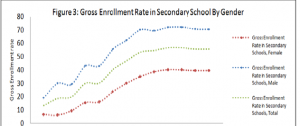Afghanistan has inherited a paralysed and almost non-operational educational system with embedded gender inequality from three decades of conflicts. According to Afghan ministry of education, after the Taliban ouster in 2001, an estimated one million children predominantly boys were attending school, while, girls were almost entirely deprived of schooling opportunities. Therefore, the government of Afghanistan joined forces with international donors and development agencies to expand equitable access to education to Afghan children, for girls in particular. However, the evidence suggests that despite an improvement in number enrollment for both boys and girls over the recent one decade and a half, the gender gap in access to education continues to persist.
read more Gender Scenario in Bangladesh: “He” or “She”
Over time, the number of girls getting access to school is increasing faster than male students in all level of education; however, the improvement has not been at the extent to fill or at least mitigate the overall enrollment gap between the two genders. Based on the recent data accessed from EMIS database of Afghan ministry of education, at primary level education, male students’ enrollment has increased from 3,393,814 in 2011-12 to 3,807,773 students in 2016-17 suggesting 12 percent improvement. While, female students’ enrollment in primary education has enhanced from 2,380,577 to 2,700,704 pupils, indicating 13.5 percent rise over the same period. Moreover, in secondary school, male students’ enrollment has increased from 1,114,028 to 1,267,410 students, indicating an increase of 14 percent over the recent years (2011-17) while female students’ enrollment has increased from 663,663 in 2011-12 to 828,498 pupils in 2016-17 suggesting 25% improvement. Furthermore, Male students Enrollment in higher secondary education has increased by 26 percent, i.e., from 630,978 students in 2011-12 to 796,671 pupils in 2016-17 while girls’ enrollment rate has increased from 388,118 to 511,827 students suggesting 32 percent improvement through 2011-2017. Irrespective of the level of education the total male students’ enrollment has improved by 13 percent while the total female students have increased by over 16 percent over the recent one decade and a half.
Figure 1 below portrays the country enrollment trend over the recent years (2011-2017) in all General Education (GE) level- Primary, secondary, and higher secondary. The figure indicates that there has been a gradual increase in overall enrollment in all stages of education while the gender gap is more or less persistent.

Source: Author’s illustration based on EMIS database of ministry of education
While the overall gross enrollment is trending upward, there is a divergent growth pattern by gender across different levels of education. Based on a longitude data retrieved from the Statistical, Economic, and Social Research and Training Centre for Islamic Countries (SESRIC) database, the female students’ Gross Enrollment Rate (GER) at primary level education is increasing at increasing rate than male students’ GER which leads to a steeper female GER curve than that of male counterparts. In other words, GER gap between the two genders has been slightly narrowing down over time in primary level education but growing wider at the secondary level of education. Put more simply, there is a converging GER trend by gender in primary level education but a diverging one in the subsequent level of education. SESRIC database does not provide sufficient data on higher secondary education level. Nevertheless, MoE database indicates a slightly diverging trend between the two genders at higher secondary education.
Figure 2, and figure 3 below illustrate the post-conflict Afghanistan’s enrollment trend. Figure 1 implies that at primary level education, enrollment gap between the two genders is dwindling over time while figure 3 suggests that enrollment gap is growing wider over time at secondary level education. Moreover, the figures imply that gradual decrease in GER gap at primary level education is mainly attributed to an average decrease in male enrollment since 2004-5. Whereas, the incremental increase in GER gap at secondary level education is due to relatively high male enrollment rate as compared to female counterpart.

Source: Author’s illustration based on SESRIC database

Source: Author’s illustration based on SESRIC database
There are regional variations in access to education across the two genders too. Based on Afghan MoE database, In provinces like Kabul, Bamyan, Balkh, Badghis, Ghor, Urozgan, Sari Pul, and Daykundi, enrollment gap between the two genders has been shrinking over time while the gap has been growing wider In Nangarhar, Kunduz, Ghazni, Takhar, Badakhshan, Paktia, Kunar, Laghman, Logar, Kandahar, Paktika, Khost, Helmand, and Zabul,. Whereas, the enrollment gap between the two genders has been consistent in the rest of the province.
read more Women in politics: overcoming the gender disparity
Overall, in post-conflict Afghanistan, access to educational opportunities is improving for both male and female students, but gender gap remains more or less stagnant over time. Nonetheless, the gap between the two sexes in access to schooling varies across different regions and levels of education which ultimately leads to two opposing directions of enrollment gap between the two genders across different provinces and levels of education. Hence, policymakers, government authorities and other stakeholders are urged to take into account these variations for any attempts to promote gender equality in access to education to children in Afghanistan.
writer Rasuldad Danish
The author is a researcher on Girls education challenging program, Bangladesh Rural Advancement Committee (BRAC- Afghanistan) who has completed his post-graduate degree from South Asian University, New Delhi. He can be reached at [email protected]

great piece with a good analysis of the situation in the country.
a good read. enjoy reading
an informative article on access to education in Afghanistan